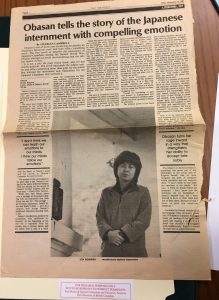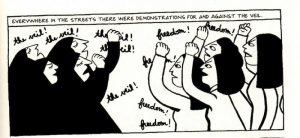Hello and welcome back from a much needed reading break! With the end of yet another semester approaching deadlines are quickly catching up and first on the list is my ASTU research essay. My chosen topic focuses on War journalism and western media’s often superficial portrayal of war, in order to support this I explored Joe Sacco’s graphic narrative Safe Area Gorazde which is set in Eastern Bosnia. In the narrative Sacco gives a personal account of his time in Gorazde while reflecting on his own flawed approach to war journalism.
The book itself is packed with prime examples of this personal reflection and critique by Sacco himself but one particular scene caught my eye on pages 26-28, the introduction to another journalist, Serif. Although Serif and Sacco have the same profession you immediately are exposed to how different they are, Serif is a Turkish national who has risked her safety and wellbeing multiple times for the sake of her work which is a stark contrast to most American/western journalists who all arrive to their destinations with army escorts and total safety in mind. The experience of American journalists is one of fantasy as their trips are fogged with a false sense of reality because of their 5 star treatment in order to keep them safe. Sarif’s tales of witnessing friends die in combat and her efforts to evacuate children to Turkey mesmerize the other Journalists as they reflect on their own cushiony experience in Gorazde. Sarif is an example of a Journalist that didn’t just visit the torn down city for a week then write a superficial article on the war, but actually became involved in the people’s suffering during the time of war itself and made sure to do something about it, immersing herself into the experience of the local people and the tragedies they endured.
I would also like to note that I do not believe every journalist now needs to become directly involved in battle and risk their lives everyday, but exposing the complete contrast between national and western journalists really helps to show just how disconnected people can become from such tragedies if their entire experience is one of comfort just for the sake of their own safety, Sarif now has a much more in depth and personal account of the tragedies of Western Bosnia and can now more accurately educate the rest of the world on the peoples awful and terrifying experiences in war.


 veil and another where a women is forced to not wear that same veil or “covering” is actually quite confusing. I find myself at a cross roads when trying to assert my opinion because when it comes to the situation in Persepolis I do not want Marji to be forced to such extreme values created by islamic radicals but in the case of the women in France I am outraged that wearing the same veil is illegal, shouldn’t everyone be able to express their own values freely? This caused me to think of the idea of a Hijab from different angles and wonder what my real opinion of it was.
veil and another where a women is forced to not wear that same veil or “covering” is actually quite confusing. I find myself at a cross roads when trying to assert my opinion because when it comes to the situation in Persepolis I do not want Marji to be forced to such extreme values created by islamic radicals but in the case of the women in France I am outraged that wearing the same veil is illegal, shouldn’t everyone be able to express their own values freely? This caused me to think of the idea of a Hijab from different angles and wonder what my real opinion of it was.